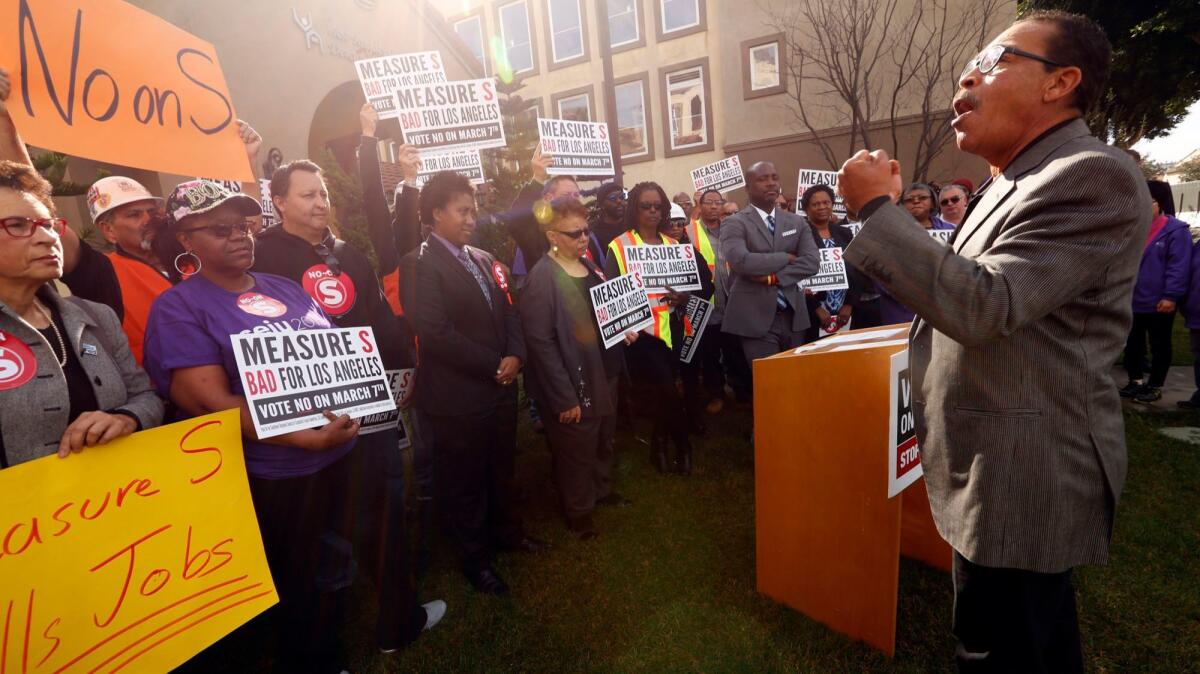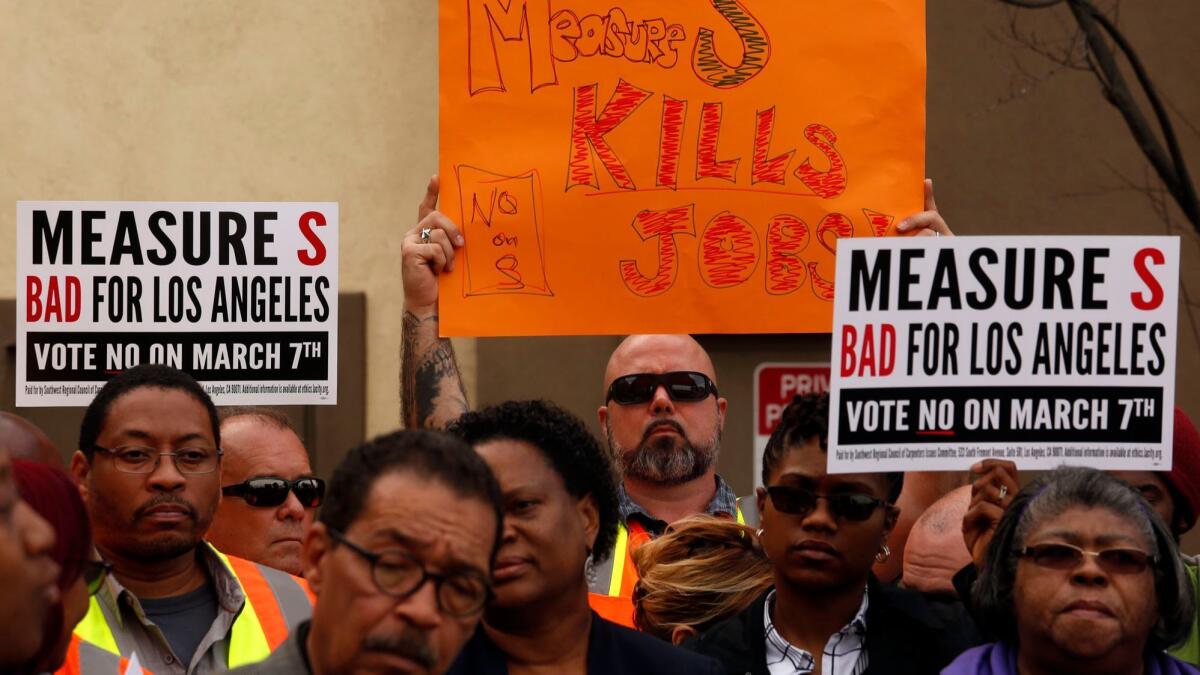Developers are finally taking interest in South L.A. Will Measure S kill those dreams?

- Share via
For decades, residents of South L.A. felt as though the development boom reshaping parts of Los Angeles was passing them by.
As developers erected looming towers in places such as downtown Los Angeles, Hollywood and the Westside, they largely avoided building on the vacant lots south of the 10 Freeway.
But in recent years, the area has finally seen something of a resurgence.
Developers have unveiled plans to build a medical center on a barren lot that has sat vacant for decades, transform a shopping mall into an “urban village” and erect a skyscraper filled with condos, apartments and almost every imaginable amenity. The Expo Line and Crenshaw/LAX Line light-rail systems are expected to draw even more investment.
And that has some residents concerned about Measure S, a slow-growth measure on the March 7 ballot. Measure S would impose a two-year moratorium on building projects that require changes in city rules to allow for re-zoning, more height or more density. It would also impose a permanent ban on projects that don’t conform with the General Plan, the citywide blueprint for development.
While opponents of Hollywood development crafted the measure, residents of South L.A. are trying to figure out how its passage would affect their growth. Some residents worry that new development will raise rents and push out working-class residents, so the measure has appeal.
But among top officials, there is fear that long-awaited projects could suddenly be in jeopardy.
“It would take a community that suffered from disinvestment for generations and make that problem even worse,” City Councilman Marqueece Harris-Dawson said of the ballot measure. It would keep the area “stuck in the development rut that we’ve been in for so many years,” continued the councilman, who represents part of South L.A.

Creators of the proposal crafted it to curb what they say is rampant overgrowth of big, dense projects in development-rich parts of the city. Those kinds of projects contribute to L.A.’s congested streets and erode a neighborhood’s character, supporters of the measure say.
But those problems can seem foreign to Angelenos in less affluent parts of town, where community advocates must sometimes spend years fighting for a neighborhood Starbucks.
South L.A. has long been plagued by an image problems tied to two riots and a history of gang violence and crime. It has struggled for decades to get basic services, such as grocery stores and sit-down restaurants. Dozens of large lots have been vacant since the 1992 riots.
And although more chain businesses have moved in recently, the region’s shopping options remain limited. Nine years ago, officials even placed a moratorium on new fast-food eateries in the area in hopes of luring healthful eateries, which has had little effect.
Measure S could undermine sorely needed new real estate developments in South L.A., the three city officials representing the region said. As examples, they pointed to 140 units of affordable housing in South Park, a development that would house the homeless in the Crenshaw neighborhood and an apartment complex in Baldwin Hills.
Harris-Dawson said he believes South L.A. would suffer “the worst unintended consequences of Measure S.” But similar concerns echo beyond Watts and South-Central into other low-income areas of Los Angeles.
In Panorama City and Van Nuys, some buildings have sat vacant since the Northridge earthquake, City Councilwoman Nury Martinez said. Only recently, she added, has she begun to see interest return to those parts of District 6.
“You cannot compare Van Nuys and Panorama City to Hollywood,” Martinez said. “If there are issues with overdevelopment in those areas, then that needs to be addressed. But to pass something that’s going to further … economically devastate communities like mine isn’t fair.”
Supporters of Measure S argue it isn’t that simple.
Nobody wants to see the Hollywood model replicated in South Los Angeles [with] luxury towers, increased gridlock and thousands of residents displaced.
— Damien Goodmon, a deputy campaign manager for the Yes on S campaign
Carl Morgan, co-chair of a South L.A. neighborhood council, is the first to admit his neighborhood needs investment. “Our boulevards are in shambles,” he said.
But the retired city planner said the type of investment matters. Thirty-story towers don’t belong in low-rise residential neighborhoods, he said. So he is voting for Measure S to help protect his community against those kinds of projects.
Still, Morgan is not against all growth. In fact, he noted that the community plans that govern land use in West Adams, Baldwin Hills and Leimert Park have recently been updated to allow denser, taller, mixed-use developments near the neighborhood’s commercial corridors.
If developers stay within the framework of those plans, Morgan thinks the region could prosper. And by steering developers away from Hollywood and the Westside, Measure S might force builders to take a harder look at Crenshaw Boulevard, he said.
“The potential of South Los Angeles has never been fully realized,” Morgan said. “We have so much more [room] to grow that if you simply developed our boulevards … there’s money to be made.”

Damien Goodmon, a deputy campaign manager for the Yes on S campaign, is taking a different tack. He is part of a coalition suing to stop the type of mega-project Morgan abhors: a 30-story building called Cumulus that would rise near La Cienega and Jefferson boulevards.
Goodmon is also taking aim at plans to renovate the Baldwin Hills Crenshaw Plaza. The proposal for the 43-acre project near a rail stop on the Crenshaw/LAX line calls for a 12-story hotel, office space and 961 apartments and condos.
“It’s likely to drastically change the character and fabric of the historic Crenshaw community,” he said. “Nobody wants to see the Hollywood model replicated in South Los Angeles [with] luxury towers, increased gridlock and thousands of residents displaced.”
Experts said good policy is often flexible and accountable to the cultural context of specific neighborhoods.
Rather than create a blanket ban on development that treats the entire city the same, policymakers need to start by developing a relationship with the public so that they can figure out what makes people feel attached to their neighborhoods, said James Rojas, an urban planner and L.A. native.
Then they should ask: “How do we use growth as a way to get what we want?” Rojas said.
Last week, dozens of residents and union members gathered outside West Angeles Villas to speak out against the moratorium. They argued that passing the measure would eliminate construction jobs and prevent senior housing projects like the Villas from being built, because such projects often require a zone change.
Annie Brown, 64, detailed her months-long struggle to find a home that fit her budget. The retired special-education specialist was approved for a one-bedroom apartment at the Villas, where said she was happy to find a community of people her age.
Still, she worries about how the city’s housing shortage will affect other seniors like her, and about the consequences of a moratorium that would stall other projects in the works.
“We need more housing,” she said. “This is not the answer.”
Times staff writer David Zahniser contributed to this report.
Twitter: @AngelJennings
Twitter: @ByMattStevens
ALSO
The luxury housing that Measure S would stop doesn’t actually require many evictions
So why is an AIDS nonprofit suing to halt construction and pushing for Measure S?
California officials and the marijuana industry are ready to fight a federal crackdown
More to Read
Sign up for Essential California
The most important California stories and recommendations in your inbox every morning.
You may occasionally receive promotional content from the Los Angeles Times.















